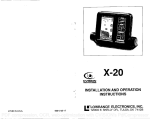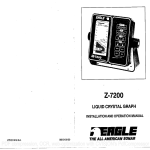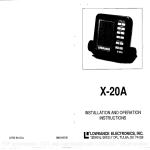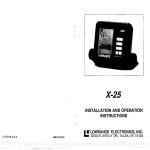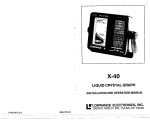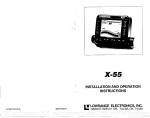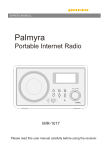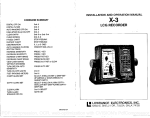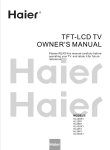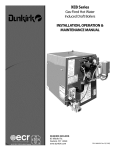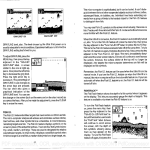Download Eagle Fish I.D. II Specifications
Transcript
4< H I I FISH I.D. AND FISH I.D. PLUS INSTALLATION AND OPERATION INSTRUCTIONS LITHO IN U.S.A. 988-0106-31 EAGI PDF compression, OCR, web-optimization with CVISION's PdfCompressor TABLE OF CONTENTS INTRODUCTION INSTALLATION POWER CONNECTIONS NOISE TRANSDUCER KEYBOARD BASICS OPERATION SENSITIVITY 1 1 1 3 3 4 7 7 CHARTSPEED RANGE ZOOM DIGITAL FISH I.D. FEATURE AUTO ALARMS CHARTALARM FISH ALARM SPEAKER LIGHT MODE TRANSDUCERS AND CONE ANGLES SIGNAL INTERPRETATION FISH ARCHES WATERTEMPERATURE AND THERMOCLINES SURVEYING A LAKE BAIT FISH HOWTO OBTAINSERVICE SPECIFICATIONS GLOSSARY 10 10 11 12 13 13 14 15 15 15 16 20 21 21 23 24 25 25 26 26 SECOND ECHO - Another echo that registers at roughly twice the depth ofa targetecho. This is caused by the sound waves reflecting off the bottom, strikingthe surface of the water, travelling to the bottom again, and returning to the surface. SECOND FUNCTION KEY - A buttonthat convertsthe functions of the primarykeys to other functions. SENSITIVITY - The ability of a sonar unit's receiverto displaytargets. Increasingthe sensitivity allows weaker targets to be displayed. Also called "gain". SCROLL SPEED - See CHARTSPEED. SHOOT-ThROUGH-HULL- A transducerinstallation which allowsthe sonar signalsto pass through a fiberglasshull withoutcuffing a hole in the hull. SUPPRESSION - A method used in some sonar units to help eliminate interference or noise. SURFACECLARITY CONTROL - Reduces or eliminates undesirable signals displayed near the water's surface. Also called "SCC". THERMOCLINE- A layerof watercaused by the meeting of warmand cool layers of water. The thermocline provides the temperature most fish prefer. TRANSDUCER - The element of a sonar system that converts the electrical energy from the transmitter into ultrasonic sound waves. When a return echo strikes the transducer, it convertsthesound waves into electrical energywhich is received and displayedby the sonar unit. TRANSOM MOUNT - A method of mounting transducers or other sensorson thetransomof theboat. Copyright© 1989, Eagle Electronics All rights reserved. UPPER/LOWERLIMIT - These are the range limits displayed on the sonar screen or paper. The upper limit is shown at the top of the display, while the lower limit is at the bottom. For example, a 20 to 30 foot range has 20 feet as theupper limit and 30 feet as thelower limit. All featuresand specifications subiectto changewithoutnotice. 29 PDF compression, OCR, web-optimization with CVISION's PdfCompressor - LCD Liquidcrystal display. The screen or display of a Liquid Crystal Graph sonar instrument. LCG - Liquid Crystal Graph. - NOISE Any undesired signal. Electrical noise is caused by engine ignitions systems, radios, etc. Acoustic noise is causedby the vibration of the engine or other mechanical sources. Noise appears on the displayas random dots or lines. OPERATING FREQUENCY- Frequency of a sonar unit's transmitter and receiver. (See kHz.) OUTPUTPOWER- The amplitude of electrical energytransmittedfrom the sonar unit to the transducer. Measured in watts, the higher the output power, thedeeper a sonar unit can read, and more detail can be displayed. PIXEL- The small dots or squareson a liquidcrystaldisplay or CAT. PIXEL DENSITY - The number of pixels per square inch on a liquid crystal display. Typically, the greater number of vertical pixels, the betterthe resolution. PULSE LENGTh - The amount of timethat the sonartransmits. This is measured in micro-seconds. The shorter the pulse length, the better theresolution. For example, a30 micro-second pulse lengthis equal to a one inch resolution. RANGE The section of water shown on the sonar display. For example, a 60 foot range has zero for the upper limit and 60 for the lower limit. REMOTE - An intelligent "repeater" unitthat receives depth information from another sonar unit. A remote doesn't have a transmitter or receiver. However,it doeshave it's own featuresthat are adjustable and operate separatelyfrom the master. RESOLUTION - The ability of a sonar unit to separate targets from each other or from the bottom. SCALE - The markings on a sonar unit's display. To determine the depth of a target, simply compare the target'slocation 10 the locationof the scale markers on the display. INTRODUCTION Welcome to the world of sportfishing sonar. Your Eagle Fish l.D. and Fish 1.0. Plus are highquality sonar designed for both professional and novice users. These units have an automatic feature that finds and displaysthe bottom depth, fish, and structure. As you becomefamiliar with your Fish 1.0., you can "fine tune" the unit to the surrounding conditionsto get the most from your sonar. (Note: All operatinginstructions forthe Fish l.D. and Fish 1.0. Plus are the same except for speed and temperature. Only the Fish l.D. Plus hasthose functions. To simplifythis manual, all references to the Fish 1.0. will also hold true for the Fish 1.0. Plus. To get started with your Fish l.D., first read the installation section. This is where it all begins, and improper installation can causeproblems down the road. After you've read these instructions and installed your Fish l.D., read the rest of this manual in detail. The more you know when you get tothe water, the moreyour Fish 1.0. will dofor you. Take this manual for reference when you head for thewater. INSTALLATION Mounting Install the unit in any convenient location, providedthere is clearance when tilted for the bestviewingangle. Holes in thebracketbase allow wood screw or through bolt mounting. Place a pieceof plywood on the back of thin panels to secure the mounting hardware. Make certain there is enough room behind the unit to attach the power and transducercables. You can routethe power and transducer cables through the one inch hole in the baseof thegimbal bracket. Then pass them through a hole in themounting surface. First passthetransducerconnectorand cable up through the hole and gimbal bracket. Then push the power cable wire down throughthe bracket and dash. After routing the cables, fill the hole with silicone rubber adhesive (RTV). Offset the bracket to coverthe majoilty of the hole. Power Connections The Fish l.D. operatesfrom a 12 volt battery system. Attach thepower cable to an accessory or power buss. If you have problems with electrical interference, then attach the cable directly to the battery. PDF compression,28 OCR, web-optimization with CVISION's PdfCompressor 1 Electrical interference shows as random dots on the display whenever the boat's engineor an accessory is on. The power cable has two wires, red is the positive lead and black is negative or ground. Attachthe in-linefuse holderto the red wire on the powercable with thecrimpconnector. The other end ofthefuseholder attaches to the battery or accessory buss. If the cable is not long enough, spliceordinary#18 gauge wire onto it. Be certainthat the fuse holder is as close to the power source (battery or accessory buss) as possible. This protectsthe powercable and your unit in the eventof a short. Use a 3-amp fuse. These units have reversepolarity protection. No damagewill occur if thepowerwires are reversed. (However, the unitwillnot work until the wires are attachedcorrectly.) CONE ANGLE - Angle of the transducers cone of sound. Eagle has transducers available with coneanglesfrom 8 to 45 degrees to suit the varying needs of fishermen. CRT - Abbreviation for Cathode Hay Tube. See Video Graph. DEFINITION- The ability of a sonar unit's display to show detail. A display with high definition can show more detail than one with low definition. DISCRIMINATION - A feature available on Eagle LC.G.'s and paper graphs that separatesfalse echoesfromtruetarget information. The Discrimination feature on Eagle sonar units removes many false signals from other sonars, acoustic and electrical sources, and more. FISH ALARM- Analarm that activates when a fish or suspended object is detected. - FISK ARCH A sonar with good resolution and definition can display suspended targets as upside down "Vees" or arches. These signals are typicallyfish, hence the name "Fish Arch". See page 20 for more FISH l.D. PLUS r information. - FLUSH MOUNT A transducer that is installedwith the bottom of the transducerflush with the bottom of the hull. FUSE HOLDER GIMBAL BRACKET - A bracket used to install a sonar unit permanently. The sonar unit can rotate in the bracket for the best viewing FROM SPEED/TEMP SENSOR angle. 12VOLT BATrERY FISK LD. 12 VOLT BAIlERY FUSE GRAYLINE This feature shows the relative strength of signals displayed on the screen. Signals weaker than theGRAYLINE setting are displayed in black, stronger targets are gray. It also givesclues to the compositionof the bottom. In other words, you can tell if the bottom is soft or hard. A hard bottomreturns a strong signalcausinga wide gray line. A soft, muddy or weedy bottom returns a weaker signal which is emphasized with a narrowgray line. IN-DASH - A sonar unit installed through a hole in the boat's dash. Usually,theface of thesonar is flush or nearlyso with the dash. kHz- Kilohertz. A measurement of frequency. Your Eagle sonar operates at 192 Kilohertz. (192,000 cycles per second). 2 27 PDF compression, OCR, web-optimization with CVISION's PdfCompressor SPEED/TEMPERATIJ RE SENSORINSTALLATION SPECIFICATIONS Dimensions Weight 5 7/8"H x 7 3/4"W x 3 7/16"D Transmitter frequency Output Power (typical) 192 kHz 275 watts peakto peak 34.4 watts RMS Receiver Sensitivity 82 db temperature stabilized Operating Current 200 ma (lights off) 500 ma (lightson) Operating Voltage 9-15 vdc Numberof pixels 50 x 27 (verticalx horizontal) 1 3/4 pounds Oncethe proper location has been determined, placethe sensoron the transom with the bottom of thesensor flush with thebottom ofthe hull. Mark thetransomin thecenter of each slot and drill a 5/32" mounting hole. Mount the sensor to the hull with the screws provided with the sensor. Use a good grade of caulking compoundto seal the screws. Adjust the senor so it is flush with the undersideof the hull and tighten 1350 Total Display Scroll Speed Maximum Chart Range Maximum Digital Range Fish l.D. Plus Only Mountthespeed/temp sensor on theboat'stransomin a locationwhere the flow of water is smoothest. There should be a minimum amountof turbulenceand air bubbles in the chosen location. The port (left) side of thetransomis preferred, however thestarboard(right) side can be used if necessary. Do not mount the speed sensor behind strakes, ribs, or thru-hullfittingsthat will disturb the flow of waterto thespeed sensor. In a typical installation, the speed sensor is mountedsix to twelve inches from the centerline of the boat. The sensormust be in thewater at all times to function properly. Make certain the chosen location is in the water evenat high speed or when the boat is on plane. the screws. .5" per minute (minimum) 32" per minute (maximum) 180 feet 400 feet GLOSSARY Ifthe baseofthetransom hasa radius,fill thegép betweenthetransom and the sensorwith caulking compound to insurea smoothwater flow. ANCHOR WATCH - A setting of the sonar unit's alarm. The alarm activates when the boat drifts into shalloweror deeperwater than the alarm set points. Route the sensor cable to the in-line connector on the sonar unit's power cable and attach it. BACK-LIGHTED- A displayor keyboardilluminated from behind by a light. Back-lighted displays are essential when night fishing or navigating. CAVITATION - Air bubbles created by the high speed movement boat or transducer through water. of a CHART SPEED - (1) The speed pf the chart paper on a paper graph recorder. (2) The speed of an image across the screen of a liquid crystalgraph. (Also called "scroll speed"). SECURELY A1TACH CABLE GOOD SPEEDITEMP SENSOR LOCATION ToTRANSOM PDF compression,26 OCR, web-optimization with CVISION's3 PdfCompressor BAIT FISH The importance of bait fish to successful fishina can't be over-emohasized. They are the principalfood of all game fish in mostwaters. Bait fish are the plankton feeding forage fish, such as minnows and shad. Bait fish can also be the young of game fish, such as crappies, bluegill, and bass. Most bali fish concentratewithin five feet of thesurface where sunlight promotesthegrowth of the plankton on which theyfeed. One method of fishing is to usethe unitto find the baitfish first. A school of baitfish will look like a "cloud" on the unit's display. Usually, game fish will be nearby,often directlybeneaththe school of baitfish. KEYBOARDBASICS This section gives a brief explanation of the keyboard. Read the Operationsectionfor a detailed description of each key's operation. ON OFF Fa.—] These L I keys turnthe unit's poweron and off. To turn it on, simply pressthe ON key. To turn it off, press the OFF key, Pressingany key generates a tone or "beep." Thistells you ________ that the unit has accepted a command. HOWTO OBTAIN SERVICE If you havea problemwith your sonar unit, please give us a chance to help beforesending it in for repair. Call or write the Factory Customer Service Department at 1-800-331-2301, extension 401, toll free. Oklahoma residents call 918-7-1,extension 401, collect. Please detail the problemyou are experiencing. The service department maybe able to save youthe inconvenience of returning your unit. If the unit must be returned, pack it carefullyso it won'tbe damaged. It is advisable to insurethe unit in case it's lost or damaged during transit. UP and DOWNARROWS These keys are used to adjust virtually every feature and function on the unit. Use thesekeys to adjustthe sensitivity, chart speed, range, zoomand chart alarm. 4 Mail To: Eagle Customer Service 12000 E. Skelly Drive Tulsa, 01< 74128 25 PDF compression, OCR, web-optimization with CVISION's PdfCompressor stay. Schooling fish suspended over deep water lie at the level that provides this temperature. We assumethey are the most comfortable here. The temperature of water in the lake is seldom constant from top to bottom. Layers of different temperatures form, and the junction of a warm and cool layer of water is called a thermocline. The depth and thickness ofthe thermocline can vary with the seasonor time of day. In deep lakes there maybe two or moreat differentdepths. Thermoclines are important to fishermen because they are areas where fish are active. Many times bait fish will be above the thermocline while larger game fish will suspend in or just below it. The Fish l.D. and l.D. Plus can detectthis invisible layer in the water, butthesensitivity will probably have to be turned up to see it. SURVEYING A LAKE The most successful anglers on any body of water are those who fish it day afterday and year after year. Eventually, they learn the hot spots that produce fish consistently. They discover through experience where, and at what depth, they can expectto find thefishthey want at any season. And they realize that these prtductive areas change throughoutthe year depending on water level, temperature, food, and other factors. Withthe Fish l.D., anyone can eliminateguesswork and concentrate on the areas where fish are likely to be. Even if ft's the first time on the lake! The most efficientway to becomeacquainted with a body of water is to survey it with your unit. Start with a map of the lake, if possible, and indicate the promising spots in relation to landmarks on shore. As you go about yoursurvey, your unit will tell youthedepth and type of bottom. It will also reveal suspendedfish. Keepa fewmarkerbuoys in the boat, ready to toss overboard. When the unit indicates a school of fish, throw thebuoy out. With the school thus marked, you can make your turn and come back to fish in exactly the right spot. This is essential when you're far from shore on a big lake. Unless you mark theschoolof fish when you're over it, you may not be able to find ft again. r 1 SENS. _______ This key and thearrow keys adjustthe graph'ssensitivity. (The digital's sensitivity is adjusted by the unit automatically.) The receiverhas 32 steps of adjustment. rm. CHARTSPEED Vary the speed of the chart with this key and the arrow keys. There are 5 steps of chart speed adjustment. 1 I I. ,J 1 1 L .1 _____ _______ RANGE The depth range is changed with this key and the arrow keys. The ranges vary from 0-5 feet to 0-180 feet. CHARTALARM Using this key activates the chart alarm. A bar appears on the left side of the display when the chart alarm is adjusted. Anytargetthat appears onthe screen betweenthe top and bottom of thechart alarm bar triggersthe alarm. PDF compression,24OCR, web-optimization with CVISION's5 PdfCompressor WATERTEMPERATUREAND THERMOCLINES Water temperature has an important-if not controlling-influence upon the activities of all fish. Fish are cold blooded and their bodies are always the temperatureof the surrounding water. During the winter, colder water slows down their metabolism. At this time, they need about a fourth as muchfood as they consume in the summer. Most fish don't spawn unless the water temperature is within rather narrow limits. The surface temperature meterbuilt into the Fish l.D. Plus helps identifythedesiredsurface waterspawning temperaturesfor various species. Trout can't survive in streams that get too warm. Bass and otherfish eventuallydie outwhen stocked in lakes that remain toocold duringthe summer. While some fish have a wider temperature tolerancethan others, each has a certain range within which it tries to 1MODE TheFish l.D. has five different"screens" or modes of [1&i]111j eration. The Fish 1.0. Plus has seven. Use this opkey to switch between modes. • • I A FISH l.D. This J key turns the Fish l.D. featureoff and on. 1 ii II 1 A FISH ALARM Press both the Fish 1.0. and the AUTO key at the sametimeto activatetheFishAlarm. This is an audiblefish alarm. 1AUTO J Turningthe uniton enables theautomatic mode. To switch to the manual mode, pressthe AUTO key. You can return the unitto automatic at anytime by pressing the AUTO key again. 6 23 PDF compression, OCR, web-optimization with CVISION's PdfCompressor BOATS DIRECTION OF TRAVEL OPERATION SENSITIVITY Theunit is in the AUTO SEARCH mode when ft's first turned on. The micro-computer automatically adjuststhe sensitivity and range to find and lock onto thebottom. The digitaldepth flashes"0" until it finds and locks onto the bottom. You can leave the sensitivity in the automatic mode or manually adjust it to suit conditions. You mayneed to increase thesensitivity to showfish symbols when the unit is in automatic. To do this, first pressthe SENS. key. The letters "SENS" will flash on the right side of the display. A verticalbar appears on the left side of the screen. ( See below.) This indicates the sensitivitylevel. To increase thesensitivity,press and holdthe up arrow key until the sensitivity is at the desired level. The down arrow key decreasessensitivity in the same manner. Notice how the sensitivity bar moves as you change settings. It will move up when the sensitivity is increased. You'll also see the change on the display. After you've finishedsetting thesensitivity level, theletters "SENS"and the sensitivity bar will disappear after eight seconds •Il A . B C Very small fish probablywill not arch at all. Medium sizedfish will show a partial arch, or a shape similar to an arch if they're in deep water. Largefish will arch, butturn thesensitivity up in deeperwaterto see the arch. Because of water conditions, such as heavy surface clutter, thermoclines, etc., the sensitivity sometimes cannot be increased enough to get fish arches. One of the best ways to get fish arches is to expand or "zoom" a segment ofthe water. For example, from45 to 60 feet. The smallerthe segment, the betterthe screen resolution will be. For the best results, turn the sensitivity up as highas possible withoutgettingtoomuchnoise on the screen. In mediumto deep water, this method should work to display fish arches. 7 PDF compression,22 OCR, web-optimization with CVISION's PdfCompressor With highsensitivity settings,a second bottomecho (secondecho) may appear. This is normal. It'scaused by the returning signal reflecting off the surface of thewater. Then it makes a second trip to the bottom and back again. Both 8 degree and 20 degreetransducers give accurate bottom readings, even though the bottom signal is much wider on the 20 degree model. This is because you are seeing more of the bottom. Remember, the shallowedge of the signalshowsyou the true depth. The rest of the signaltells you whether you are over rocks, mud, etc. SIGNAL INTERPRETATION Your unit givesan accuratepicture of the bottomthat your boat is passing. A bottom of firm sand, gravel, shell, or hard clay returns a wide bottom signal. If the automaticfeature is off and the bottom signal narrows , then it means that you have moved over a mud bottom. Mud absorbs the sound wave and returns a weak signal. Turn up the sensitivity to see a better bottomsignal. Big rocks or stumps on a smooth bottom send back signals above the bottom level signal. The height of the signal depends on the target's height. As you pass over a post, it should be clearly visible as a short line extending above the bottom signal. A steep slope returns a wide signal, the steeperthe wider. Signals returned from a high underwater cliff are usually the widest of all. Brush usually lies on the bottom and shows up as clumpsrising above the bottom signal. Brush signals look similarto large rocks; however Remember, when the unit's automatic feature is on, the receiver'ssensitivity automatically adjuststo thesurrounding conditions. The microcomputerplaces it at a level slightlyabovetheminimum required to pick up the bottom signal. However, ft's possible to change the sensitivity level whilethe unit is in automatic. Thismaybe desirableif the sensitivity level is not high enoughto showfish or other small detail. The unit will increase the sensitivity to pick up the bottom signal, then add in the level you programmed. To adjust the sensitivity while the unit is in automatic, simplypress the SENS. key. Then press either the up arrow key to increase it, or the down arrow key to decrease it. As you press the arrow key, the sensitivity bar moves up or down, according to the sensitivity level chosen. You can adjustthesensitivity in the same manner whentheunitis in the manual mode. 8 their signal is not as strong as rock. FISH ARCHES Fish arches are created when the cone of sound passesover a fish. The distance to a fish when the cone first strikes ft is shownas "A" on the next page. When the center of the cone strikes the fish, the distance is shorter, as shown in "B". As the cone leaves the fish, the distanceincreases again as shown in "C". When the Fish l.D. feature is off, the depth of the water will affect the size and shape of the fish arch due to the cone angle diameter. For example, if the cone passes over a fish in shallow water, the signal displayedon theunit may not arch at all. Thisis due to the narrowcone diameterand the resolution limitations of thedisplay. 21 PDF compression, OCR, web-optimization with CVISION's PdfCompressor TRANSDUCERS AND CONE ANGLES The sound waves from the transducer spread out into the water in a cone shaped beam. This looks much like the beam from a flashlight. The angle between theoutside edges of the cone is the coneangle. Eagleoffers a choiceof transducers with either an 8 or 20 degreecone angle. Typically, wide cone angle transducers (20 degrees) are ideal for operating in shallow to medium water depths. The 20 degree cone angle allows you to see more of the underwater world. In 15 feet of water the 20 degree cone covers an area about six feet across. The 8 degree transducer covers only about a two foot circle. CHARTSPEED At power on, thechart speed scrolls at a preset speed. To changethe speed, pressthe CHART SPEED key. The word "CHART" will flash on the right side of the display. A vertical bar will also appearon the left side of the screen. This indicates the currentchart speed. Next, press the up arrow key if you wish to increase the chart speed. Press the down arrow key to decreaseit. When the chart reaches the desired speed, release the key. Thereare five steps of chart speed. Whenthe chart speed reachesits maximum or minimum level, the unit will sound a tone. ____- The 20 degree transduceris almost always the best to use in fresh water,the 8degree mostly in salt water. In a deep water environment, (300 feet - fresh water, 100 feet - salt water) the narrow cone angle is more desirable. Since the sound energy is concentrated in a smaller area, it can penetrate to much deeper depths. n LI AUTO CHART AN 311 CL' CS 50' rn 100' 150' 200' 2O°at3.- 8°at3db To view thechart speed without changing it, pressthe CHARTSPEED key. The chart speed bar will appearfor eight seconds. At times it is desirable to stop or "freeze" the display to examine an echo before it scrolls off the screen. Pressing theSENS. and CHART SPEEDkeys at the same time will freeze thedisplay. Press the SENS. and CHARTSPEED keys again to start the display moving at the last chart speed selling. If thedigital sonar is on, the bottom depth will still bedisplayed. The digital doesnot stopwhen thechart is in the "freeze" mode. 20 9 PDF compression, OCR, web-optimization with CVISION's PdfCompressor RANGE The range automatically changes to keep the bottom signal on the display when the unit is in automatic. The range cannot be changed when the unit is in the automatic mode. The range can be changed in manual mode. There are six ranges available:0-5, 15, 30, 60, 120, and 180 feet. To changetherange, first make certainthewordAUTO is off. Then press the RANGE key. The word RANGEwill flash on the right side of the screen. Next, press the up arrow key to switch to a shallower rangeor pressthe down arrow key for a deeper range. The rangeannunciatorwill stopflashingeight secondsafter thelast keywas MODE 6- Fish l.D. ONLY Depth only displayedin large digits. No chart displayed. pressed. Cu FISH C. 1-an MODE 7 - Fish l.D. I, U and l.D. Plus II All chart, High Speed Scroll. In this mode the chart scrolls at ZOOM - Automatic operation Use theZoom featureto increase the size of the targets on the display. It works by enlarging the bottom half of the selected range. For example, if the range is 0 - 60 feet and the zoom key is pressed, the new rangewill be 30 - 60 feet. Iftheunit is in automatic,thebottom will be tracked in this 30 foot window. There are twoexceptionsto this rule: 1) If you're on the 0-15' range and press thezoom key, the new range will be 10-15'. 2) There is no zoom on the 0-5' range. To change the zoom range, first press the ZOOM key. The word "ZOOM" flashes on the right side of the screen. Now press the up arrow or the down arrow key to increase or decreasethe zoom size. For example, ifthe rangeis 0-60feet, pressing theZOOM key changes the rangeto 30-60 feet. While the word "ZOOM" is still flashing,press the up arrow key. This changes thezoom rangefrom 30 feet to 15 feet. Pressthe up arrow key again, and thezoomrangechanges to fivefeet. To turnthe zoom featureoff, simply press the RANGEkey. 10 high speed. The chart speed can be adjusted with the CHARTSPEED key if desired. a) Chart uses full screen. RANGE 'In Cu 1.ialiic_tt b) No digital depth indicator. c) NoFASTRAK. d) No automatic operation allowed. / LSfl -Hi !___ e) No Fish 1.0. feature or Fish Alarm f) Chart alarm is allowed. 19 PDF compression, OCR, web-optimization with CVISION's PdfCompressor ZOOM- Manual Mode Zoom operates differently when the unit is in the manual mode. First presstheZOOM key. The bottomhalf of the range is enlarged, just like the automatic zoom feature. However, if you press an arrow key, the range shifts in one foot increments. The down arrow key to shiftsthe range down in one toot increments. The up arrow keyshifts the range up in one foot increments. For example, if the unit is on the 0-60 foot range, and the manual mode is on, pressing the zoom key, then the down arrow key once will movethe 30-60' range to 31'-61'. The best way to use this feature is to change the range to a smaller one, then press the zoom key, shift the range until the area is displayedthat you want zoomed. For example, ifthebottomdepth is 50 feet, and you wish to enlargethearea immediately above it, first changethe rangeto 0-3D feet. Now pressthe zoom key. Finally, pressthedown arrow keyuntil thebottom appears. Nowyou have a fifteenfoot zoom windowaround the bottom signal. MODE5- Fish l.D. Plus ONLY Big digital Depth with speed. Same as mode 4 exceptspeed is displayedinstead of temperature. MODE 6 - Fish 1.0. Plus Only Depth, Speed, Log, and Temperaturedisplayed in large digits. The chart is turned off. The numbersontheright side of the display normally used for the range are converted into letters, according to their function. For example, sp is speed in statute miles per hour. dL stands for distance log in statute miles, and oF for degrees Fahrenheit. All functions display in tenths. The log begins when the unit is turned on. The unit must be turned off to reset the distance log. ' 121 I*2t -M'stW-r. 1" qa. zoa _II 4,- 52 5dL 83L'I 505 52 951 DIGITAL Built inside theFish l.D. is a complete digital sonar. It automatically discriminates between the valid bottom echoesand false echoes from fish, thermoclines, or other signals. The digital display will show only the bottom depth. At power on, the digital will flash "0" until it has "locked on" to the bottom signal. Once it has acquiredthe bottomdepth, it will show it in the lower left corner of the display. PDF compression,18 OCR, web-optimization with CVISION's PdfCompressor 11 FISHI.D. The Fish I.D. featureis automatically on when theunit is first turned on. The computerinsidethe unitanalyzes all echoes,filteringoutunwanted signals. It helps eliminatesurface clutter, thermoclines,and other undesirable signals. The remaining suspended targets are usually fish. Targets that are identified by the unit as fish are displayed as small, medium, or large fish symbols on the display. These symbols are shownaccording to therelative size ofthefish as seenby theunit. The Fish l.D. featurecan only be usedin automatic. If you wishtoturnit off, orback on again,presstheFISH I.D. key. Ifyou pressthe FISH 1.0. key when the unit is in manual,it will put it in automatic and enablethe Fish 1.0. feature. 3- ________ MODE Fish l.D. and l.D. Plus Big digital. a) The digital depth numbers use WI AUJO the lower quarter of the display. The depth is displayed in tenths of a foot to 99.9 feet, then it is displayed in whole numbers. b) No FASTRAK. Temperature, or Speed indicators. To show fish symbols, you must be traveling at a slow trolling speed. There should be somemovement of theboat forthe Fish l.D. featureto - 30 -t • uu work properly. If you havedifficultyshowing fish symbols, try increasingthe sensitivity. NOTE:The Fish 1.0.feature cannot distinguish between fish and other suspendedobjects such as turtles, tree branches, trotlines, submerged floats, or other inanimate objects. The micro-computer in this unit is sophisticated, but it can be fooled. The mostdifficult challenge is individual MODE 4- - Fish 1.0. PIus ONLY Same as above, but temperature displayadded above the depth. tree branches extending out from groups of branches. These can be mis-identified as fish by the Fish l.D. feature. Also, large amounts of noise can fool the Fish I.D. feature. This is usually caused by a poor transducerinstallation. Although the Fish 1.0. feature isn't perfect, it can be a valuable aid to thefisherman. 12 17 PDF compression, OCR, web-optimization with CVISION's PdfCompressor MODE The Fish I.D. hasfive differentscreen modes. The Fish I.D. Plus has seven. To change modes on both units, press the MODE key. Keep pressingthe MODE key until the desired screen appears. A summary of the differentscreen modes follows. - Fishl.D.andl.D. This is the default Plus when the unit is mode used on. It has thefolfirst turned lowingfeatures: MODE 1 - Mi(FO. RAN liii Cu Small digital depth display in lower left corner. It does not show tenths of a foot. Normalchart display. a) j-I FI1 701 AUTO When the unit is first turned on, the automatic feature is enabled. It works automatically to find and display the bottomdepth. Thesensitivity and range are also adjusted to keepthe bottom signal on the screen at all times. To turnthe automatic feature off, simply press the AUTO keyonce. The word "AUTO" will disappear from the display, signifying the automaticsensitivity and chart range features are off. This also turns the Fish l.D. featureoff at the sametime. The digital remainson. To return the unit to the automatic mode, press the AUTO key again. This will reset the sensitivity, so you may wish to increase it to see fish or other detail. This will notturn the Fish l.D. featureon. You will have to pressthe Fish 1.0. key to turn it on. j-- 'in' -it' b) No FASTRAK. 2- Fish 1.0. and 1.0. Plus - This is the same as mode 1 except it has FASTRAK. This displayson the right side of the screen. It converts all echoes to horizontal bars when they first appear on the screen. This gives a rapid update of conditions directly under the Echoes are also scrollednormally across the display. The Fish l.D. feature is not available with this mode. j Li AUTO 'C r MODE iti.r, T_•••• 50___uSO 'I Flu 4: 'I FISH AUTO 1. r n 'in -'LI ALARMS The unit has two different alarms, a chart alarm and FishAlarm. The chart alarm consistsof a barthat displays on the left side of thescreen. The alarm "chirps" whenever the unit detects an echo inside the boundariesof thebar. di U Fish Alarm sounds an audible alarm when fish or other suspended objects are detected. It works in conjunction with the Fish l.D. feature. To separatethe alarms, the fish alarm's tone sounds differentthan the chart alarm. Both alarms may be used at the sametime. Jr boat. r 5- — . S-rn Sn iii .L :t::i= := PDF compression,16 OCR, web-optimization with CVISION's13 PdfCompressor CHART ALARM To setthe ChartAlarm, press the CHARTALARMkey on the keyboard. The words "Chart Alarm"flashesin thelower right cornerofthescreen. A verticalbar also displays on the left side of the screen. It will stay on the screen foreight seconds or foreight seconds afteryou havefinished adjustingit. This is theChart Alarm's "window."Any echothat appears between the top and bottom of this bar will sound the alarm. Adjust deep end of thisbar to make a smalleror largeralarm "window." The shallowend is automatically adjusted by the unitso it won't be triggered by surfaceclutter or otherfalse signals. Next, press thedown arrow to move the bottom of the bar deeper, or press the up arrow to move it shallower. Eightsecondsafter the last button is pressed,the alarm bar will disappear. To turn the Chart Alarm off, press theCHARTALARM key, then move thebottom of thebar all theway to its shallowest positionusing theup arrow key. FISH ALARM Use the FISH ALARM for a distinctiveaudiblealarm when fish or other susupended objects are detected by the FISH 1.0. feature. Press the FISH I.D. and the AUTO keys at the same time. The words "FISH ALARM" displays at the bottom right side of the screen. The audible alarm sounds each time the Fish I.D. feature detects a fish or other suspendedobject. Thereis a different tone for eachfish symbol size. To turn the Fish Alarm off, press the FISH I.D. and AUTO keys at the same time. SPEAKER The speaker can be turned on and off by pressing the up and down arrow keys at the same time. The speaker is represented by a note symbol above the arrow keys. Whenever it is enabled,a note symbol appearson the right center side ofthedisplay. The speakeris enabled when theunit is turnedon. NOTE: This applies to the alarms only. The unit will still sound a tone when a key is pressed and the speaker is turned off. SA— j When the "Chart Alarm" signal is on, the alarm is active. If you wish to view the Chart Alarm bar, simplypress the CHARTALARM key. The bar will be displayed for eight seconds. Any target that appearson the left side of the screen in the area covered by the chart alarm bar will triggerthealarm. If the range is changed,the Chart Alarm may need to be changedalso LIGHT A light allows operationof the unit at night. Turning the unit on causes the lights to flash for six seconds. Press the RANGEand ZOOM keys at the sametime and the lights will stay on. To turn the lights off, press theRANGEand ZOOM keys again. The lights will also go outwhen the unit is turned off. C r -J since it does not track range settings. 14 15 PDF compression, OCR, web-optimization with CVISION's PdfCompressor
















